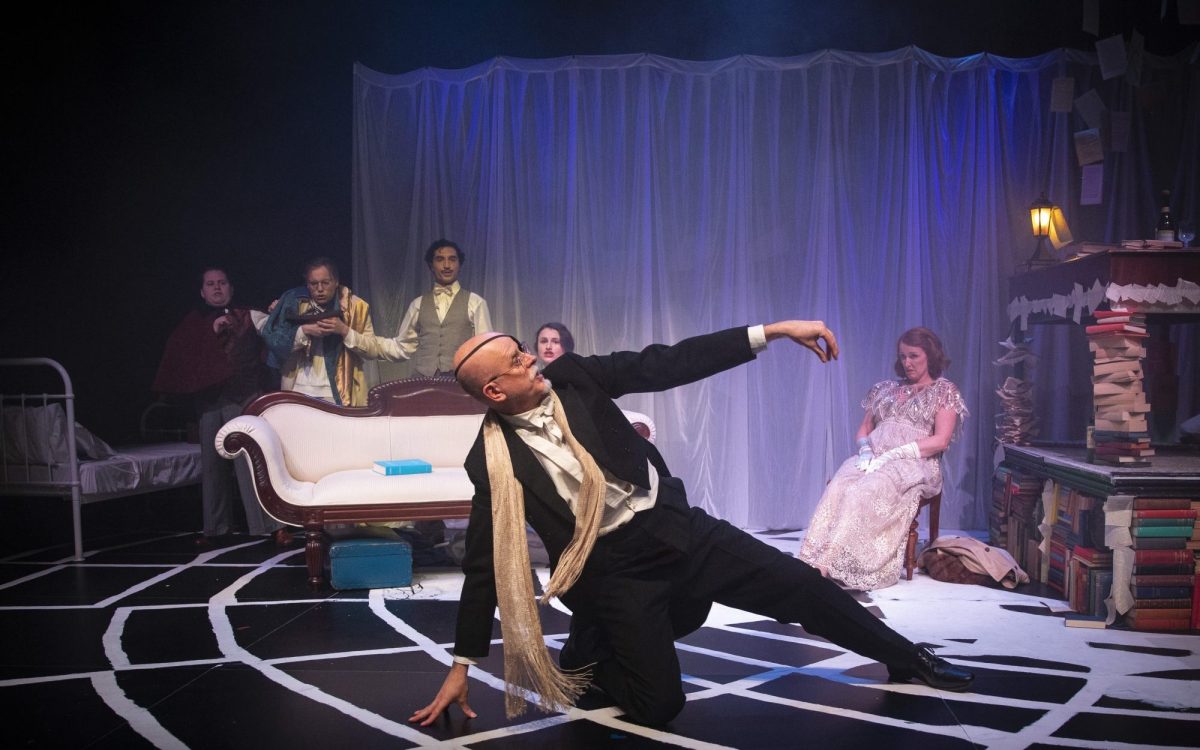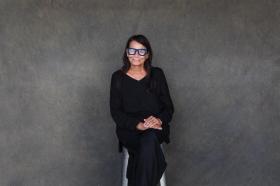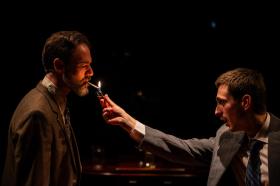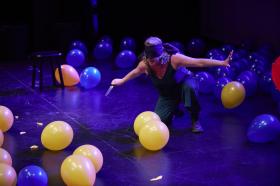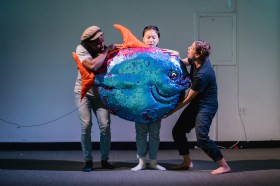The 31st Bloomsday festival in Melbourne features another original play, this time by writer and producer, Steve Carey. Samuel Beckett and the Rainbow Girl explores the period when Irish novelist James Joyce and his family were living in Paris in the 1920s. The play centres around Joyce’s daughter, Lucia, and where she fits into the family dynamic; especially after the then relatively unknown, fellow Irish writer Samuel Beckett, enters the family circle.
When the lights come up, Lucia is lying on a hospital bed, with white bed sheets covering the rest of the set and a white curtain across the back, together evoking a mental institution. A slick-looking, black clad Beckett enters to visit her and they begin reminiscing about the past and Lucia’s talent for dancing.
The scene jumps back to 1928 and Joyce – tall and imposing in a white suit with a walking stick, his left eye covered by the signature black eyepatch beneath normal glasses – takes centre stage. Behind him, white sheets were removed to reveal a settee, a simple writing desk, a small outdoor table for a Paris café, and an impressive elevated desk, with legs made from books and dozens of single writing pages hanging from the ceiling above it.
Beckett is soon introduced to the Joyce family by his friend, Tomasso Grigio. The wife, Nora, and kids, Lucia and Georgio, are instantly enamoured of him.
It’s not long until the centrepiece scene arrives, where everyone is dressed “to the nines”, drinking and celebrating a decade since Joyce’s novel Ulysses was published. They’re raucously hanging off each other and taking turns to sing a verse of Finnegan’s Wake … except Lucia that is.
From there, the Joyce family starts spiralling as they navigate a multitude of issues.
The play’s use of music helps mark different scenes, which are varying in length. The lighting design includes an art deco desk lamp that appears and disappears from Joyce’s elevated desk, and the singing interludes are charming and well-prepared.
For most of the performance Lucia (Mary Agnes O’Loughlin) is dancing – whether she’s in the background of conversation or a monologue, or at the centre of a scene. The choreography is well-suited to the show and O’Loughlin does a great job at keeping the energy up. At times her Irish accent slips, making it hard to tell if she’s highlighting Lucia’s state of mind or if it’s an accidental slip-up.
Tref Gare does an amazing job of showing the many faces of Joyce – an evocative writer, loving husband and father (who squanders money), and someone struggling with severe eye problems. At times, his Irish accent was a little too thick and fast to understand the lines, but overall, it held up well.
The most interesting scenes are Nora’s monologues, as they move from comedic to more emotional as the play progresses. They’re beautifully portrayed by Carissa McPherson and help give voice to the “great woman behind the great man”, further illustrating how often women’s stories have been pushed down in the past to “prop up” the myths of the tortured and great male artist toiling away alone.
Paolo Bartolomei is a tour de force as both Beckett’s friend Grigio and the polio-inflicted doctor treating Beckett, by appearing naturally comedic or dramatic as the character and scene requires.
Read: Theatre review: The Woman in Black, QPAC
While the play’s name suggests Beckett will feature strongly in the show, he only makes sparingly brief appearances, making it difficult for Jeremy Harland to really showcase his talent. On the other hand, Daniel Cook provides a nice balance to the Joyce family’s drama as the demure Georgio.
Altogether, you don’t need to be a Joyce or literary aficionado to enjoy this play; although you’ll probably be all the more entertained if you are.
Samuel Beckett and the Rainbow Girl
Presented by Bloomsday in Melbourne at St Martin’s Theatre
Writer and Producer: Steve Carey
Director: Carl Whiteside
Performers: Mary Agnes O’Loughlin, Tref Gare, Jeremy Harland, Paolo Bartolomei, Carissa McPherson, Daniel Cook
Artistic Director: Frances Devlin-Glass
Production Assistant: Rachael Vassallo
Stage Manager: Kate Weston
Set Designer: Silvia Shao
Costumer Designer: Frida Moss
Lighting Designer: Lindon Blakey
Sound Designer: Tom Kunz
Choreographer: Jaimee White
Music Director: Felix Meagher
Tickets: $38-$44
Samuel Beckett and the Rainbow Girl will be performed at St Martin’s Theatre until 23 June.
